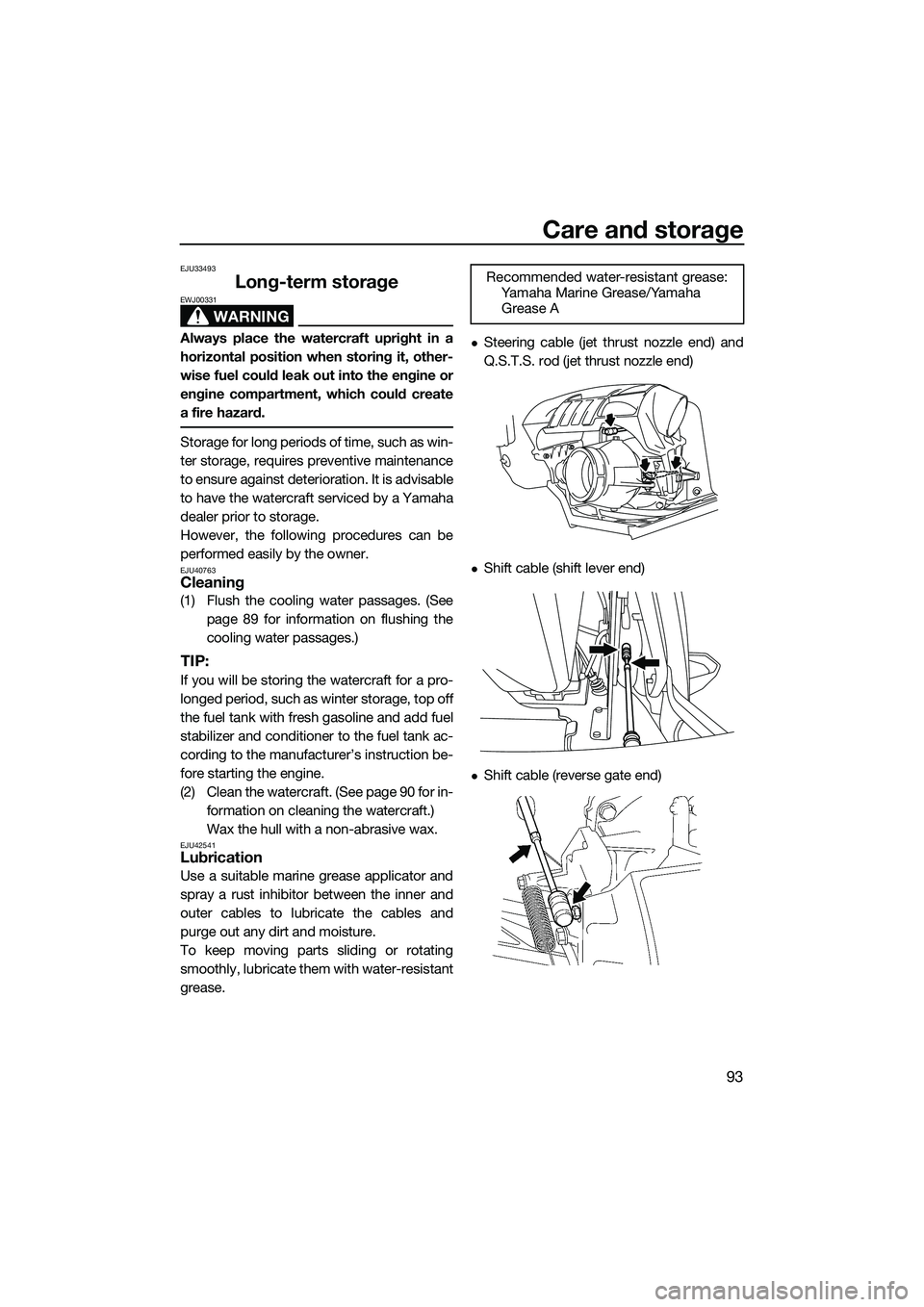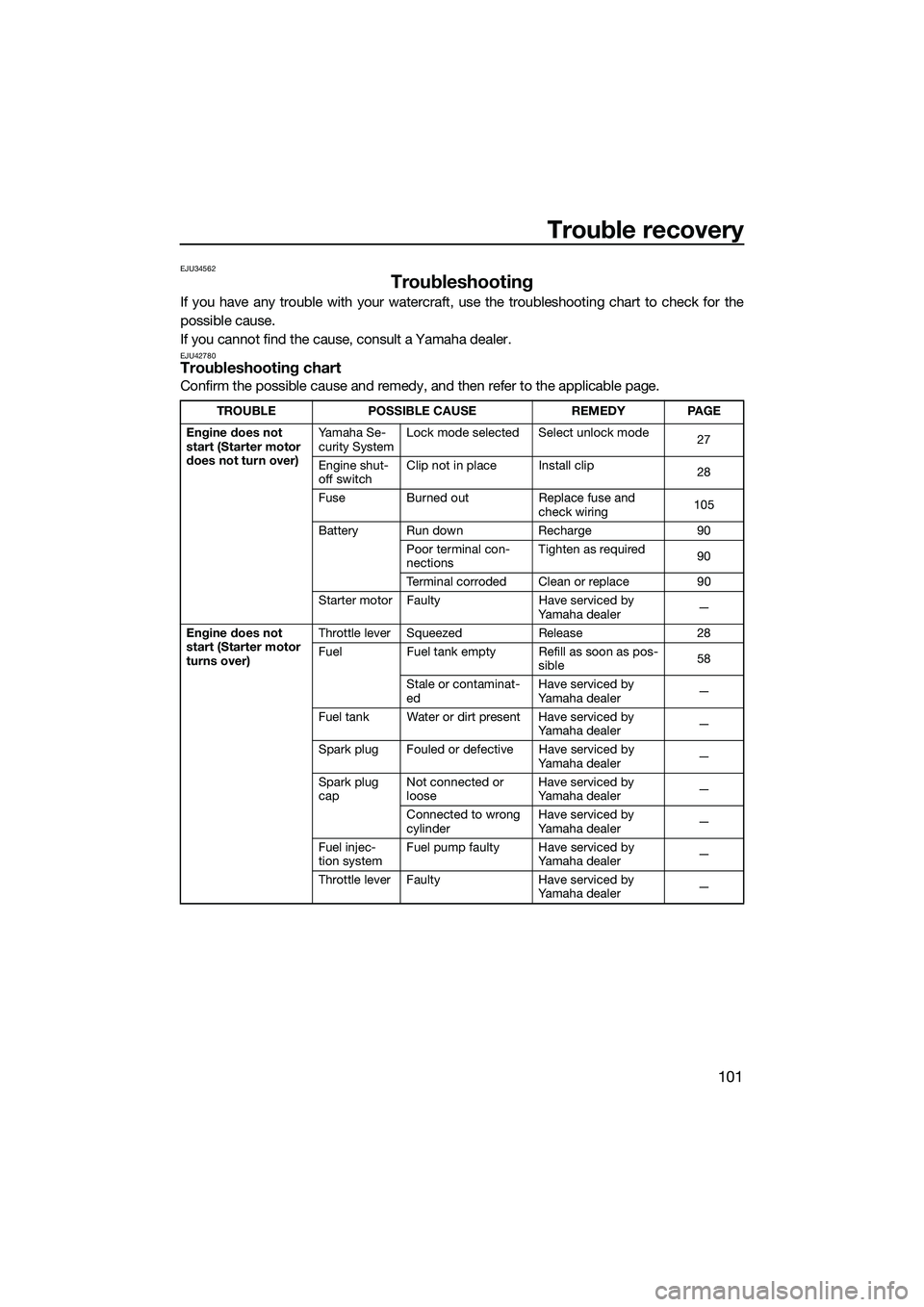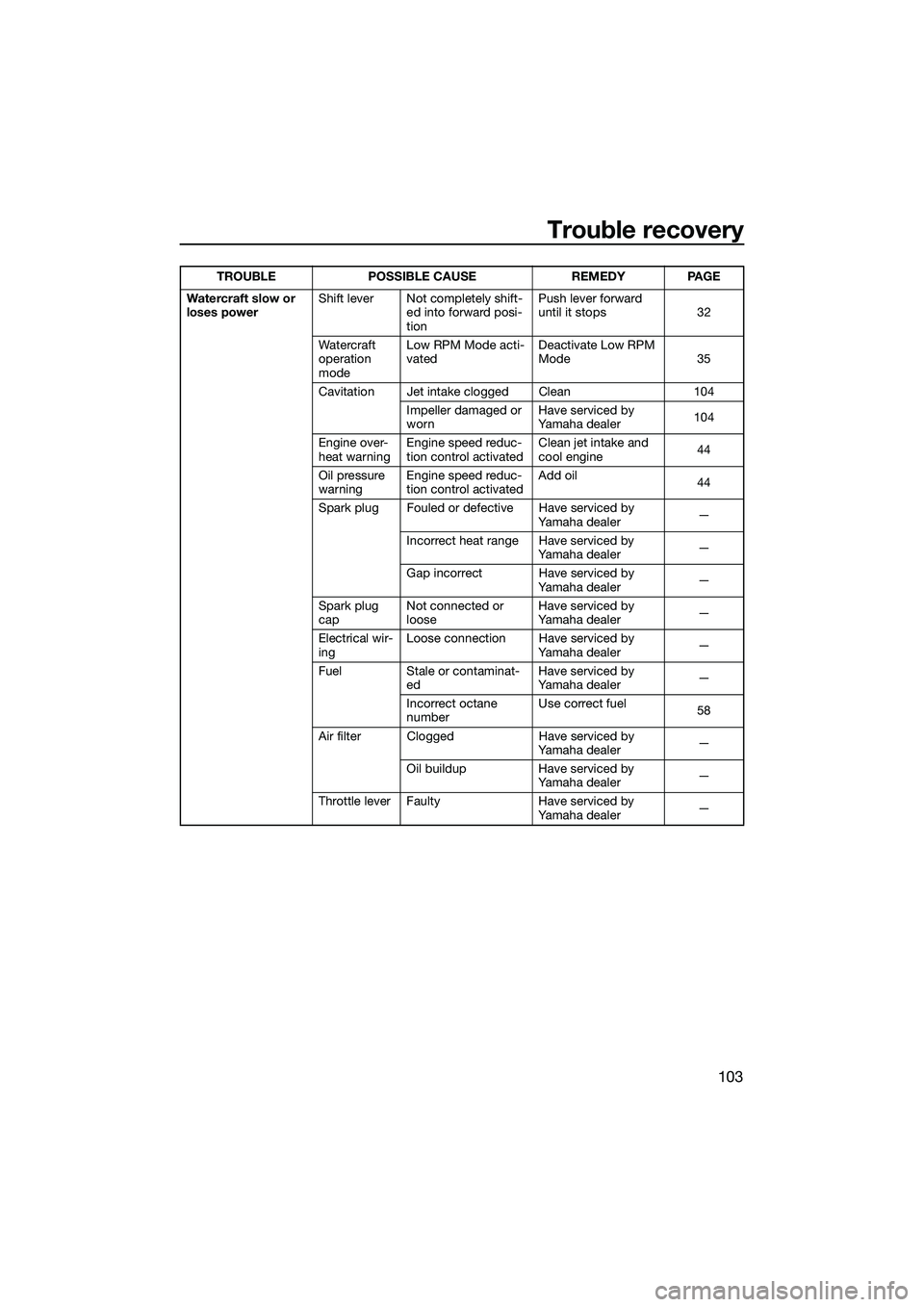2014 YAMAHA FX SVHO service
[x] Cancel search: servicePage 49 of 118

Instrument operation
43
TIP:
The hour meter is selected at the Yamaha
factory.
Hour meter
The hour meter shows the total number of
hours that the engine has been running since
the watercraft was new.
TIP:
The elapsed time will be kept even if the bat-
tery terminals have been disconnected.
To switch to the hour meter from the voltme-
ter:
Push the “VOLT/HOUR” button for at least 1
second after the multifunction information
center is activated for more than 10 seconds.
The display switches to the hour meter from
the voltmeter.Voltmeter
The voltmeter shows the battery voltage.
When the battery voltage is normal, the volt-
meter displays approximately 12 volts.
If the battery voltage has dropped significant-
ly, “LO” is displayed on the voltmeter. If the
battery voltage has risen significantly, “HI” is
displayed. If “LO” or “HI” is displayed, imme-
diately return to shore and have a Yamaha
dealer service the watercraft.
To switch to the voltmeter from the hour me-
ter:
Push the “VOLT/HOUR” button for at least 1
second after the multifunction information
center is activated for more than 10 seconds.
The display switches to the voltmeter from
the hour meter.
EJU31515Fuel level meter
The fuel level meter shows the amount of fuel
remaining in the fuel tank. The amount of re-
maining fuel is shown using eight display
segments, which disappear two at a time as
the fuel level decreases.
1
Hour meter/voltmeter
1 “VOLT/HOUR” button
2 Hour meter
1
21
1“VOLT/HOUR” button
2 Vo l t m et e r
21
UF3J70E0.book Page 43 Wednesd ay, October 9, 2013 2:07 PM
Page 99 of 118

Care and storage
93
EJU33493
Long-term storage
WARNING
EWJ00331
Always place the watercraft upright in a
horizontal position when storing it, other-
wise fuel could leak out into the engine or
engine compartment, which could create
a fire hazard.
Storage for long periods of time, such as win-
ter storage, requires preventive maintenance
to ensure against deterioration. It is advisable
to have the watercraft serviced by a Yamaha
dealer prior to storage.
However, the following procedures can be
performed easily by the owner.
EJU40763Cleaning
(1) Flush the cooling water passages. (Seepage 89 for information on flushing the
cooling water passages.)
TIP:
If you will be storing the watercraft for a pro-
longed period, such as winter storage, top off
the fuel tank with fresh gasoline and add fuel
stabilizer and conditioner to the fuel tank ac-
cording to the manufacturer’s instruction be-
fore starting the engine.
(2) Clean the watercraft. (See page 90 for in-formation on cleaning the watercraft.)
Wax the hull with a non-abrasive wax.
EJU42541Lubrication
Use a suitable marine grease applicator and
spray a rust inhibitor between the inner and
outer cables to lubricate the cables and
purge out any dirt and moisture.
To keep moving parts sliding or rotating
smoothly, lubricate them with water-resistant
grease.
Steering cable (jet thrust nozzle end) and
Q.S.T.S. rod (jet thrust nozzle end)
Shift cable (shift lever end)
Shift cable (reverse gate end)Recommended water-resistant grease:
Yamaha Marine Grease/Yamaha
Grease A
UF3J70E0.book Page 93 Wednesd ay, October 9, 2013 2:07 PM
Page 103 of 118

Maintenance
97
EJU43100Periodic maintenance chart
The periodic maintenance chart gives general guidelines for periodic maintenance. Have a
Yamaha dealer perform the checks in the following chart. However, maintenance may need to be performed more frequently depending on your operating conditions. If you have any
questions, consult a Yamaha dealer.
This “ √” mark indicates items to be checked and serviced by a Yamaha dealer.
Item OperationInitial Thereafter every
Page
10 hours 50 hours
or 12
months *1 100
hours or 12
months *1 200
hours or 24
months *1
Fuel line Check fuel hoses and
clamps
√
—
Fuel filler cap/Wa-
ter separator Check O-rings for cracks
and deformation
√
—
Fuel tank Check installation and
straps
√
—
Water inlet strainer Check for clogs and dam-
age
√
—
Cooling water hos-
es Check for damage and
leakage, and check
clamps
√
—
Engine oil Replace √√ 99
Oil filter Replace √99
Intermediate hous-
ing Lubricate
√—
Spark plugs Check √√ —
Battery Check specific gravity of
electrolyte, terminals,
bands, and breather hose √
—
Battery leads Check terminals √—
Steering master Check operation and for
looseness
√√
—
Steering cable Check exterior and con-
nections, and lubricate
√
—
Q.S.T.S. cable Check exterior and con-
nections, and lubricate
√
—
Q.S.T.S. converter
and rod Check exterior and con-
nections, and lubricate
√√
—
Shift lever Check exterior and con-
nections, and lubricate
√
—
Shift cable and re-
verse gate Check exterior and con-
nections, and lubricate
√
—
UF3J70E0.book Page 97 Wednesd ay, October 9, 2013 2:07 PM
Page 107 of 118

Trouble recovery
101
EJU34562
Troubleshooting
If you have any trouble with your watercraft, use the troubleshooting chart to check for the
possible cause.
If you cannot find the cause, consult a Yamaha dealer.
EJU42780Troubleshooting chart
Confirm the possible cause and remedy, and then refer to the applicable page.
TROUBLEPOSSIBLE CAUSE REMEDYPAGE
Engine does not
start (Starter motor
does not turn over) Ya m a h a S e -
curity System
Lock mode selected Select unlock mode
27
Engine shut-
off switch Clip not in place Install clip
28
Fuse Burned out Replace fuse and
check wiring 105
Battery Run down Recharge90
Poor terminal con-
nections Tighten as required
90
Terminal corroded Clean or replace 90
Starter motor Faulty Have serviced by
Yamaha dealer —
Engine does not
start (Starter motor
turns over) Throttle lever Squeezed
Release28
Fuel Fuel tank empty Refill as soon as pos-
sible 58
Stale or contaminat-
ed Have serviced by
Yamaha dealer
—
Fuel tank Water or dirt present Have serviced by Yamaha dealer—
Spark plug Fouled or defective Have serviced by Yamaha dealer—
Spark plug
cap Not connected or
loose Have serviced by
Yamaha dealer
—
Connected to wrong
cylinder Have serviced by
Yamaha dealer
—
Fuel injec-
tion system Fuel pump faulty Have serviced by
Yamaha dealer —
Throttle lever Faulty Have serviced by
Yamaha dealer —
UF3J70E0.book Page 101 Wednesd
ay, October 9, 2013 2:07 PM
Page 108 of 118

Trouble recovery
102
Engine runs irregu-
larly or stallsFuel Fuel tank empty Refill as soon as pos-
sible58
Stale or contaminat-
ed Have serviced by
Yamaha dealer
—
Incorrect octane
number Use correct fuel
58
Fuel tank Water or dirt present Have serviced by Yamaha dealer—
Spark plug Fouled or defective Have serviced by Yamaha dealer—
Incorrect heat range Have serviced by Yamaha dealer —
Gap incorrect Have serviced by Yamaha dealer —
Spark plug
cap Not connected or
loose Have serviced by
Yamaha dealer
—
Cracked, torn, or
damaged Have serviced by
Yamaha dealer
—
Electrical wir-
ing Loose connection Have serviced by
Yamaha dealer —
Fuel injec-
tion system Faulty or clogged in-
jectors Have serviced by
Yamaha dealer
—
Warning light or in-
dicator blinks or
comes on Fuel level
warning
Fuel tank empty Refill as soon as pos-
sible 58
Oil pressure
warning Oil pressure dropped Have serviced by
Yamaha dealer 44
Engine over-
heat warning Jet intake clogged Clean
104
Check en-
gine warning Faulty sensors Have serviced by
Yamaha dealer 45
TROUBLE POSSIBLE CAUSE REMEDY PAGE
UF3J70E0.book Page 102 Wednesd
ay, October 9, 2013 2:07 PM
Page 109 of 118

Trouble recovery
103
Watercraft slow or
loses powerShift lever Not completely shift-
ed into forward posi-
tion Push lever forward
until it stops 32
Watercraft
operation
mode Low RPM Mode acti-
vated
Deactivate Low RPM
Mode 35
Cavitation Jet intake clogged Clean 104 Impeller damaged or
worn Have serviced by
Yamaha dealer
104
Engine over-
heat warning Engine speed reduc-
tion control activated Clean jet intake and
cool engine
44
Oil pressure
warning Engine speed reduc-
tion control activated Add oil
44
Spark plug Fouled or defective Have serviced by Yamaha dealer—
Incorrect heat range Have serviced by Yamaha dealer —
Gap incorrect Have serviced by Yamaha dealer —
Spark plug
cap Not connected or
loose Have serviced by
Yamaha dealer
—
Electrical wir-
ing Loose connection Have serviced by
Yamaha dealer —
Fuel Stale or contaminat- ed Have serviced by
Yamaha dealer
—
Incorrect octane
number Use correct fuel
58
Air filter Clogged Have serviced by Yamaha dealer—
Oil buildup Have serviced by Yamaha dealer —
Throttle lever Faulty Have serviced by Yamaha dealer—
TROUBLE POSSIBLE CAUSE REMEDY PAGE
UF3J70E0.book Page 103 Wednesd
ay, October 9, 2013 2:07 PM
Page 113 of 118

Trouble recovery
107
(7) Securely install the seats in their originalpositions.
If the fuse immediately blows again, the elec-
trical system may be defective. If this occurs,
have a Yamaha dealer service the watercraft.
EJU41822Replacing the bilge pump fuse
If the fuse is blown, replace it with the proper
fuse.
To replace the fuse:
(1) Remove the seats and engine cover. (See page 49 for seat removal and instal-
lation procedures and page 95 for engine
cover removal and installation proce-
dures.)
(2) Remove the plastic ties that are securing the corrugated tube and bilge pump fuse
leads.
TIP:
Be careful not to drop the plastic ties into the
engine compartment.
(3) Pull out the bilge pump fuse holder fromthe rubber cover, and then remove the
fuse cover.
(4) Replace the blown fuse with the spare fuse of the correct amperage.
WARNING! Do not use fuses of a dif- ferent amperage than recommended.
Substitution with a fuse that has an
improper rating can cause extensive
electrical system damage and possi-
ble fire.
[EWJ00803]
TIP:
If the fuse is difficult to remove, use the fuse
puller on the reverse side of the electrical box
1 Good fuse
2 Blown fuse
2
1
1 Bilge pump fuse lead
2 Plastic tie
3 Corrugated tube
213
UF3J70E0.book Page 107 Wednesd ay, October 9, 2013 2:07 PM
Page 114 of 118

Trouble recovery
108
cap. (See page 105 for information on the
fuse puller.)
(5) Securely install the fuse cover, and thenfit the bilge pump fuse holder into the
rubber cover.
(6) Secure the bilge pump fuse leads and corrugated tube with the plastic ties.
(7) Securely install the engine cover and seats in their original positions. If the fuse immediately blows again, the elec-
trical system may be defective. If this occurs,
have a Yamaha dealer service the watercraft.
EJU34716Towing the watercraft
WARNING
EWJ00812
The operator of the towing boat must
keep speed to a minimum and avoid
traffic or obstacles which could be a
hazard to the operator on the water-
craft.
The towline should be long enough so
that the watercraft will not collide with
the towing boat when slowing down.
If the watercraft becomes inoperative in the
water, it can be towed to shore.
To tow the watercraft:
Use a towline that is three times the com-
bined length of the towing boat and the wa-
tercraft.
(1) Securely attach the towline to the bow
eye of the watercraft being towed.
(2) Sit astride the seat and hold on to the handlebars in order to balance the water-
craft. NOTICE: The bow must be kept
up out of the water during towing, oth-
erwise water could flood the engine
compartment or water could flow
1 Bilge pump fuse holder
2 Fuse cover
3 Spare fuse
4 Fuse
Fuse amperage:
Bilge pump fuse:3 A
1Bilge pump fuse lead
2 Plastic tie
3 Corrugated tube
4 Rubber cover
21
43
213
41Bow eye
1
UF3J70E0.book Page 108 Wednesd ay, October 9, 2013 2:07 PM